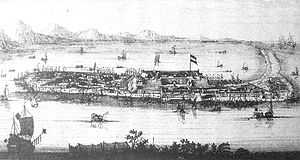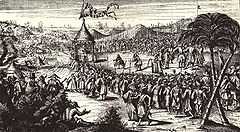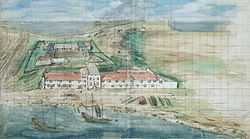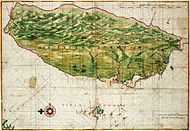Siege of Fort Zeelandia
| Siege of Fort Zeelandia (1661–1662) | |||||||
|---|---|---|---|---|---|---|---|
| Part of Sino–Dutch conflicts | |||||||
 Fort Zealandia, 17th century. | |||||||
| |||||||
| Belligerents | |||||||
|
Koxinga's Ming Loyalist army Koxinga's Ming Loyalist fleet Taiwanese Aborigines who defected from the Dutch forces |
| ||||||
| Commanders and leaders | |||||||
| Koxinga |
| ||||||
| Strength | |||||||
|
25,000 soldiers and sailors Hundreds of war vessels. |
Garrison: 1,200[1] unknown number of native allies and civilians Reinforcement: 10 ships, 700 sailors | ||||||
| Casualties and losses | |||||||
|
unknown (about 1,000 killed or wounded in a failed frontal assult in September 1660 according to Dutch records) |
1,600 killed or diseased 2 ships sunk 3 vessels captured | ||||||
The Siege of Fort Zeelandia (Chinese: 鄭成功攻臺之役; pinyin: Zhèng Chénggōng gōng tái zhī yì; literally: "Koxinga's Invasion of Taiwan"), which took place in 1661 and 1662, ended the Dutch East India Company's rule over Taiwan and began the Kingdom of Tungning's rule over the island. Taiwanese scholar Lu Chien-jung described this event as "a war that determined the fate of Taiwan in the four hundred years that follow".[2]
Prelude
The Dutch had been defeated in a war over the Pescadores from 1623–1624, and again at the Battle of Liaoluo Bay where the Chinese were led by Zheng Zhilong, the father of Koxinga.
In the year of 1659, after an unsuccessful attempt to capture Nanjing, Koxinga, leader of the Ming loyalist remnants, felt that the Qing Empire had already consolidated their position in China, and that his troops needed more supplies and manpower. He began actively searching for a suitable location as his base of operation, and soon a Chinese man named He Bin (Chinese: 何斌), who was working for the Dutch East India Company in Formosa (Taiwan), fled to Koxinga's base in Xiamen and provided him with a map of Taiwan.[3]
By 1632, the Dutch had established a post on a peninsula named Tayoan (Traditional Chinese: 大員, now Anping District of Tainan), which was separated from the main part of Formosa by a shallow lagoon historically referred to as the Bay of Taijiang (臺江內海). The Dutch fortification consisted of two forts around the bay. The first was the multiple-walled Fort Zeelandia situated at the entrance to the bay; this was the main fortification of the Dutch. The second was Fort Provintia, a walled administrative office located at the bay, which was smaller in size. Frederick Coyett, the governor of Taiwan for the company, was stationed in Fort Zeelandia with 1,800 men; his subordinate, Valentyn, was in charge of Fort Provintia and its garrison of 500 men.
The Siege


Koxinga and his fleet set sail from Kinmen on March 23, 1661. His fleet consisted of hundreds of junks and ships of various sizes, with roughly 25,000 soldiers and sailors aboard. They arrived in the Pescadores the next day, left a garrison there, and set sail again on March 30. The fleet arrived at Tayoan on April 2, and, after passing through a shallow waterway unknown to the Dutch, landed at Luermen (Lakjemuyse;[5] Chinese: 鹿耳門) in the bay.
Koxinga was abundantly provided with cannons and ammunition in addition to two companies of former Dutch slaves of African descent who had learned to use small arms. They caused much harm to the Dutch during the war.[6] His troops wore iron scale armor and either used two handed swords, swords and shields, or bows and arrows. Swordsmen were intended to cause "fearful massacre amongst the fugitives" after enemy lines were smashed through by shield bearers, since Koxinga had no cavalry to break through the enemy forces.[7]
The assault force immediately laid siege to Fort Provintia, catching Valentyn unprepared since the fort was supposedly protected by Fort Zeelandia; facing overwhelming enemy forces, Valentyn surrendered the fort on April 4. Three days after the capture of Fort Provintia, Koxinga's troop surrounded Fort Zeelandia and demanded the garrison's surrender by sending Dutch priest Antonius Hambroek, who had been captured by Koxinga's forces, as emissary to persuade the garrison to surrender. Hambroek, however, urged the garrison to resist instead of surrender, and was executed after returning to Koxinga's camp. Koxinga ordered his artillery to advance and used 28 cannon to bombard the fort.[8]
Koxinga's fleet then began massive bombardment, and troops on the ground attempted to storm the fort, but were repulsed with considerable losses. Koxinga then changed his tactics and laid siege to the fort. On May 28, news of the siege reached Jakarta, and the company decided to send a fleet of 10 ships and 700 sailors to relieve the fort. The fleet arrived on July 5 and had some small scale confrontations with Koxinga's fleet upon its arrival.
On July 23, the two sides gave battle as the Dutch fleet attempted to break the blockade while Koxinga's fleet tried to hold off the Dutch. After a brief engagement, the Dutch fleet was forced to retreat with two ships sunk, three smaller vessels captured, and 130 casualties. The Dutch attempted to break the siege again in October, but were beaten back by the besieging army. This victory, coupled with news of low morale among the garrison from deserted German mercenaries, convinced Koxinga to launch a final unsuccessful assault in December.[9]
According to Frederick Coyett's account written after the siege to absolve himself of the Dutch defeat, in January 1662, a Dutch defector named Hans Jurgen Radis gave Koxinga critical advice on how to capture the fortress from a redoubt whose strategic importance had gone hitherto unnoticed by the Chinese forces. Koxinga followed his advice and the Dutch redoubt fell a day later.[9][10] This claim of a Dutch defector only appears in Coyett's account and Chinese records make no such mention of any defector.
On January 12, 1662, Koxinga's fleet began another bombardment, while the ground force prepare to assault the fort. With supplies dwindling and no sign of reinforcement, Coyett finally ordered the hoisting of the white flag and negotiated the surrender terms. The surrender was made complete on February 1, and the remaining Dutch East India Company personnel left Taiwan on February 17. All personnel were allowed to take with them their personal belongings, as well as provisions sufficient for them to reach the nearest Dutch settlement.
Taiwanese aborigines
The Taiwanese Aboriginal tribes who were previously allied with the Dutch against the Chinese during the Guo Huaiyi Rebellion in 1652 turned against the Dutch during the Siege of Fort Zeelandia and defected to Koxinga's Chinese forces.[11] The Aboriginals (Formosans) of Sincan defected to Koxinga after he offered them amnesty, the Sincan Aboriginals then proceeded to work for the Chinese and behead Dutch people in executions, the frontier aboriginals in the mountains and plains also surrendered and defected to the Chinese on May 17, 1661, celebrating their freedom from compulsory education under the Dutch rule by hunting down Dutch people and beheading them and trashing their Christian school textbooks.[12]
Aftermath
After arriving in Jakarta, Coyett was imprisoned for three years and tried for high treason, surrendering the post and the loss of valuable goods. He was pardoned and exiled to the most eastern of the Banda Islands. He was eventually released in 1674 after strong lobbying by his friends and relatives. He published a book named Neglected Formosa (Dutch: 't Verwaerloosde Formosa) in 1675. In the book he defended his actions in Taiwan and criticized the company for neglecting his pleas for reinforcement.
After the loss of the post at Tayoan, the Dutch East India Company made several attempts to recapture it, and even formed an alliance with the Qing Empire to battle Koxinga's fleet. They captured Keelung in northern Taiwan, but were forced to abandon it due to logistical difficulties and because the Qing fleet suffered numerous crushing defeats at the hands of Koxinga's veteran sailors.
Dutch prisoners

During the Siege of Fort Zeelandia the Chinese took Dutch women and children prisoner. The Dutch missionary Antonius Hambroek, two of his daughters, and his wife were among the Dutch prisoners of war with Koxinga. Koxinga sent Hambroek to Fort Zeelandia demanding he persuade them to surrender or else Hambroek would be killed when he returned. Hambroek returned to the Fort, where two of his other daughters were. He urged the Fort not to surrender, and returned to Koxinga's camp. He was then executed by decapitation, and in addition to this, a rumor was spreading among the Chinese that the Dutch were encouraging the native Taiwan aboriginals to kill Chinese, so Koxinga ordered the mass execution Dutch male prisoners in retaliation, in addition to a few women and children also being killed. The surviving Dutch women and children were then turned into slaves. Koxinga took Hambroek's teenage daughter as a concubine,[13][14][15] and Dutch women were sold to Chinese soldiers to become their wives, the daily journal of the Dutch fort recorded that "the best were preserved for the use of the commanders, and then sold to the common soldiers. Happy was she that fell to the lot of an unmarried man, being thereby freed from vexations by the Chinese women, who are very jealous of their husbands."[16] In 1684 some of these Dutch wives were still captives of the Chinese.[17]
Some Dutch physical looks like auburn and red hair among people in regions of south Taiwan are a consequence of this episode of Dutch women becoming concubines to the Chinese commanders.[18] The Chinese took Dutch women as slave concubines and wives and they were never freed: in 1684 some were reported to be living, in Quemoy a Dutch merchant was contacted with an arrangement to release the prisoners which was proposed by a son of Koxinga's but it came to nothing.[19] The Chinese officers used the Dutch women they received as concubines.[20][21][22] The Dutch women were used for sexual pleasure by Koxinga's commanders.[23] This event of Dutch women being distributed to the Chinese soldiers and commanders was recorded in the daily journal of the fort.[24]
A teenage daughter of the Dutch missionary Anthonius Hambroek became a concubine to Koxinga, she was described by the Dutch commander Caeuw as "a very sweet and pleasing maiden".[25][26]
Dutch language accounts record this incident of Chinese taking Dutch women as concubines and the date of Hambroek's daughter[27][28][29][30]
Cultural influences
The battle was depicted in the movie The Sino-Dutch War 1661 (Chinese: 鄭成功1661), which ended in Koxinga's victory over the Dutch.
See also
References
 This article incorporates text from The island of Formosa, past and present: History, people, resources, and commercial prospects. Tea, camphor, sugar, gold, coal, sulphur, economical plants, and other productions, by James Wheeler Davidson, a publication from 1903 now in the public domain in the United States.
This article incorporates text from The island of Formosa, past and present: History, people, resources, and commercial prospects. Tea, camphor, sugar, gold, coal, sulphur, economical plants, and other productions, by James Wheeler Davidson, a publication from 1903 now in the public domain in the United States. This article incorporates text from The island of Formosa: historical view from 1430 to 1900, by James Wheeler Davidson, a publication from 1903 now in the public domain in the United States.
This article incorporates text from The island of Formosa: historical view from 1430 to 1900, by James Wheeler Davidson, a publication from 1903 now in the public domain in the United States.
- ↑ Manthorpe (2009), p. 65.
- ↑ 盧建榮 (1999). 入侵台灣:烽火家國四百年 (in Chinese). Taipei: 麥田出版. ISBN 957708916X.
- ↑ Andrade (2005), §15.
- ↑ http://www.taiwandocuments.org/koxinga.htm
- ↑ Campbell (1903), p. 544.
- ↑ Coyett (1903), p. 421.
- ↑ Lach & Kley (1998), pp. 18-21.
- ↑ Davidson (1903), p. 38.
- ↑ 9.0 9.1 Andrade (2008).
- ↑ Struve (1998), p. 232.
- ↑ Covell, Ralph R. (1998). Pentecost of the Hills in Taiwan: The Christian Faith Among the Original Inhabitants (illustrated ed.). Hope Publishing House. pp. 96–97. ISBN 0932727905. Retrieved December 10, 2014.
- ↑ Hsin-Hui, Chiu (2008). The Colonial 'civilizing Process' in Dutch Formosa: 1624 - 1662. Volume 10 of TANAP monographs on the history of the Asian-European interaction (illustrated ed.). BRILL. p. 222. ISBN 900416507X. Retrieved December 10, 2014.
- ↑ Moffett, Samuel H. (1998). A History of Christianity in Asia: 1500-1900. Bishop Henry McNeal Turner Studies in North American Black Religion Series. Volume 2 of A History of Christianity in Asia: 1500-1900. Volume 2 (Issue 36 of American Society of Missiology series) (2, illustrated, reprint ed.). Orbis Books. p. 222. ISBN 1570754500. Retrieved December 10, 2014.
- ↑ Moffett, Samuel H. (2005). A history of Christianity in Asia, Volume 2 (Issue 36 of American Society of Missiology series) (2 ed.). Orbis Books. p. 222. ISBN 1570754500. Retrieved December 10, 2014.
- ↑ Free China Review, Volume 11. W.Y. Tsao. 1961. p. 54. Retrieved December 10, 2014.
- ↑ Manthorpe, Jonathan (2008). Forbidden Nation: A History of Taiwan (illustrated ed.). Macmillan. p. 77. ISBN 0230614248. Retrieved December 10, 2014.
- ↑ Covell, Ralph R. (1998). Pentecost of the Hills in Taiwan: The Christian Faith Among the Original Inhabitants (illustrated ed.). Hope Publishing House. p. 96. ISBN 0932727905. Retrieved December 10, 2014.
- ↑ Manthorpe, Jonathan (2008). Forbidden Nation: A History of Taiwan (illustrated ed.). Macmillan. p. 77. ISBN 0230614248. Retrieved December 10, 2014.
- ↑ Covell, Ralph R. (1998). Pentecost of the Hills in Taiwan: The Christian Faith Among the Original Inhabitants (illustrated ed.). Hope Publishing House. p. 96. ISBN 0932727905. Retrieved December 10, 2014.
- ↑ Lach, Donald F.; Van Kley, Edwin J. (1998). Asia in the Making of Europe, Volume III: A Century of Advance. Book 4: East Asia. Asia in the Making of Europe Volume III (Book 4) (revised ed.). University of Chicago Press. p. 1823. ISBN 0226467694. Retrieved December 10, 2014.
- ↑ Manthorpe, Jonathan (2008). Forbidden Nation: A History of Taiwan (illustrated ed.). Macmillan. p. 72. ISBN 0230614248. Retrieved December 10, 2014.
- ↑ Manthorpe, Jonathan (2008). Forbidden Nation: A History of Taiwan (illustrated ed.). Macmillan. p. 77. ISBN 0230614248. Retrieved December 10, 2014.
- ↑ Heaver, Stuart (26 February 2012). "Idol worship". South China Morning Post. p. 25. Archived from the original on Feb 26, 2012. Retrieved December 10, 2014.
- ↑ Manthorpe, Jonathan (2008). Forbidden Nation: A History of Taiwan (illustrated ed.). Macmillan. p. 77. ISBN 0230614248. Retrieved December 10, 2014.
- ↑ Wright, Arnold, ed. (1909). Twentieth century impressions of Netherlands India: Its history, people, commerce, industries and resources (illustrated ed.). Lloyd's Greater Britain Pub. Co. p. 67. Retrieved December 10, 2014.
- ↑ Newman, Bernard (1961). Far Eastern Journey: Across India and Pakistan to Formosa. H. Jenkins. p. 169. Retrieved December 10, 2014.
- ↑ Muller, Hendrik Pieter Nicolaas (1917). Onze vaderen in China (in Dutch). P.N. van Kampen. p. 337. Retrieved December 10, 2014.
- ↑ Potgieter, Everhardus Johannes; Buys, Johan Theodoor; van Hall, Jakob Nikolaas; Muller, Pieter Nicolaas; Quack, Hendrik Peter Godfried (1917). De Gids, Volume 81, Part 1 (in Dutch). G. J. A. Beijerinck. p. 337. Retrieved December 10, 2014.
- ↑ Zeeuw, P. de (1924). De Hollanders op Formosa, 1624-1662: een bladzijde uit onze kolonialeen zendingsgeschiedenis (in Dutch). W. Kirchner. p. 50. Retrieved December 10, 2014.
- ↑ Algemeene konst- en letterbode, Volume 2 (in Dutch). A. Loosjes. 1851. p. 120. Retrieved December 10, 2014.
Bibliography
- Andrade, Tonio (2008). "Chapter 11: The Fall of Dutch Taiwan". How Taiwan Became Chinese : Dutch, Spanish and Han Colonization in the Seventeenth Century. New York: Columbia University Press. ISBN 9780231128551.
- Campbell, William (1903). "Explanatory Notes". Formosa under the Dutch: described from contemporary records, with explanatory notes and a bibliography of the island. London: Kegan Paul. OCLC 644323041.
- Coyett, Frederick (1903) [First published 1675 in 't verwaerloosde Formosa]. "Arrival and Victory of Koxinga". In Campbell, William. Formosa under the Dutch: described from contemporary records, with explanatory notes and a bibliography of the island. London: Kegan Paul. pp. 412–459. LCCN 04007338.
- Davidson, James W. (1903). "Chapter III: Formosa under the Dutch 1644-1661". The island of Formosa, past and present: History, people, resources, and commercial prospects. Tea, camphor, sugar, gold, coal, sulphur, economical plants, and other productions. London and New York: Macmillan. LCCN 03022967. OL 6931635M.
- Lach, Donald F.; Kley, Edwin J. Van (1998). Asia in the Making of Europe: A Century of Advance : East Asia. Chicago: University of Chicago Press. ISBN 0226467694. Retrieved 2010-06-28.
- Manthorpe, Jonathan (2009). Forbidden nation : a history of Taiwan (1st Palgrave Macmillan pbk. ed. ed.). New York: Palgrave Macmillan. ISBN 978-0230614246.
- Struve, Lynn A. (1998). Voices from the Ming-Qing cataclysm: China in tigers' jaws. New Haven: Yale University Press. ISBN 0300075537. Retrieved 2010-06-28.
| ||||||||||||||||||||||||||||||||
